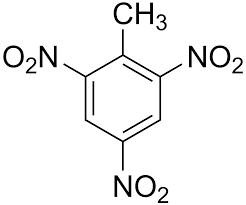
Answer
378.3k+ views
Hint: The short form of trinitrotoluene is TNT. It is a pale yellow solid organic compound. It’s more specific name is $ 2,{\text{ }}4,{\text{ }}6 - trinitrotoluene $ . TNT is made up of carbon, hydrogen, oxygen, and nitrogen. The bonds between these elements are very strong.
Complete answer:
Trinitrotoluene is popularly known as TNT. Its molecular formula is $ {C_6}{H_2}\left( {N{O_2}} \right)3C{H_3} $ . The structure of TNT is as follows:

It contains carbon, hydrogen, oxygen, and nitrogen strongly bonded to each other. TNT is a solid organic compound but it has the property of quickly changing its solid form to hot expanding gas resulting in an explosion. And so TNT or Trinitrotoluene is used as an explosive.
TNT was invented by German chemist Julius Wilbrand in 1863. It was originally used as a yellow dye. Then later in 1891 a German chemist, Carl Haussermann discovered its explosive properties.
Preparation of TNT in industries takes place in three steps:
First toluene is nitrated with a mixture of sulfuric acid and nitric acid. And mono-nitrotoluene (MNT) is generated. Then this MNT is isolated and reacted with dinitrotoluene to produce dinitrotoluene (DNT). Finally, anhydrous mixtures of nitric acid oleum are used and DNT is nitrated to trinitrotoluene (TNT). Hence TNT is produced.
Therefore the correct option is D. an explosive.
Note:
TNT explosive is easy to handle. It is widely used in military, mining, and automotive applications.it is different from other explosives. People who are exposed to TNT may get anemia, skin irritation, cataract, and abnormal liver function. TNT explosive is highly destructive and can cause mass deterioration.
Complete answer:
Trinitrotoluene is popularly known as TNT. Its molecular formula is $ {C_6}{H_2}\left( {N{O_2}} \right)3C{H_3} $ . The structure of TNT is as follows:

It contains carbon, hydrogen, oxygen, and nitrogen strongly bonded to each other. TNT is a solid organic compound but it has the property of quickly changing its solid form to hot expanding gas resulting in an explosion. And so TNT or Trinitrotoluene is used as an explosive.
TNT was invented by German chemist Julius Wilbrand in 1863. It was originally used as a yellow dye. Then later in 1891 a German chemist, Carl Haussermann discovered its explosive properties.
Preparation of TNT in industries takes place in three steps:
First toluene is nitrated with a mixture of sulfuric acid and nitric acid. And mono-nitrotoluene (MNT) is generated. Then this MNT is isolated and reacted with dinitrotoluene to produce dinitrotoluene (DNT). Finally, anhydrous mixtures of nitric acid oleum are used and DNT is nitrated to trinitrotoluene (TNT). Hence TNT is produced.
Therefore the correct option is D. an explosive.
Note:
TNT explosive is easy to handle. It is widely used in military, mining, and automotive applications.it is different from other explosives. People who are exposed to TNT may get anemia, skin irritation, cataract, and abnormal liver function. TNT explosive is highly destructive and can cause mass deterioration.
Recently Updated Pages
what is the correct chronological order of the following class 10 social science CBSE

Which of the following was not the actual cause for class 10 social science CBSE

Which of the following statements is not correct A class 10 social science CBSE

Which of the following leaders was not present in the class 10 social science CBSE

Garampani Sanctuary is located at A Diphu Assam B Gangtok class 10 social science CBSE

Which one of the following places is not covered by class 10 social science CBSE

Trending doubts
Which are the Top 10 Largest Countries of the World?

What percentage of the solar systems mass is found class 8 physics CBSE

Fill the blanks with the suitable prepositions 1 The class 9 english CBSE

The Equation xxx + 2 is Satisfied when x is Equal to Class 10 Maths

How do you graph the function fx 4x class 9 maths CBSE

Give 10 examples for herbs , shrubs , climbers , creepers

Difference Between Plant Cell and Animal Cell

Why is there a time difference of about 5 hours between class 10 social science CBSE

Difference between Prokaryotic cell and Eukaryotic class 11 biology CBSE



